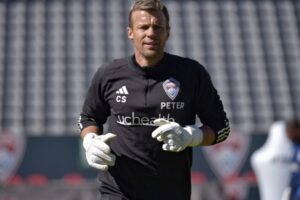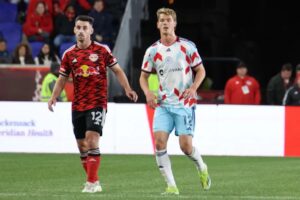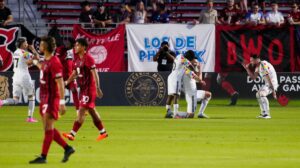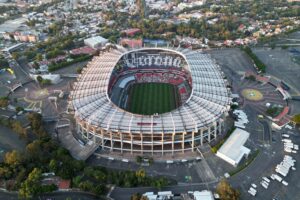Editorial (November 8, 2017) – The LA Galaxy Academy is consistently regarded as one of the best academy systems in MLS. It’s considered to be up there with the likes of FC Dallas and the New York Red Bulls. If you ask me, it’s overrated.
Unpopular Opinion: The LA Galaxy Academy Is Overrated
The LA Galaxy operate academy teams at the U-12, U-14, U-16, and U-18 level. In 2015, they founded the LA Galaxy Academy Academic Program, essentially a fully operational high school curriculum integrated with their academy for their academy teams. LA Galaxy II started in the USL in 2014 as the first MLS 2 team in the league.
Since the Academy’s inception, the following players have signed MLS level contracts with the club: Jose Villarreal, Jack McBean, Gyasi Zardes, Oscar Sorto, Raul Mendiola, Bradford Jamieson IV, Nathan Smith, Jaime Villarreal, and Hugo Arellano. The Galaxy have also had players like Paul Arriola and Haji Wright who left the club before getting signed. Los Dos have a number of Galaxy Academy products on their roster as well.
What An Academy Is Supposed To Do:
At its purist and simplest level, a soccer team’s academy system is supposed to produce players for the first time. It takes a village to raise a child, and thus it takes a full academy system and several age groups of academy teams to develop one professional player. For every preteen who signs as an academy player and makes it one day to the first team, there’s at least ten players who flame out.
In the new age of World Football, teams use their academies for other things as well. Smaller clubs from sell-on leagues will use them to fill in the depth of the roster if they cannot afford large transfer fees for big name players. When the right opportunity presents itself, they’ll sell a star academy product to reinvest in the club (buy several other players, reinvest in club infrastructure, avoid relegation, etc.). See the Eredivise, several small clubs in Germany, and Sporting KC.
Other larger clubs will use global networks to find and develop the best talent. Players who aren’t able to make it, go out on loan, and the big club will sell them on to recuperate some of the cost of this large infrastructure. See La Masia, the recent City Football Group affiliate system, etc.
So How Has The LA Galaxy Academy System Done:
In terms of consistent playing time, only Gyasi Zardes has put together back-to-back seasons where he was a regular starter. Still, other than his 16 goal season in 2014, his numbers at the forward position have been relatively pedestrian. He was playing at right back to end the year and his future (club, country, and position) are all up in the air.
Other than McBean and Jose Villarreal, it’s hard to judge any of the other academy products. They haven’t been around as long and haven’t been given as many chances to play at the MLS level (more on that later). Any conclusions on them would be short sighted due to the small sample size.
Of the other two, they haven’t done much. There was a lot of optimism about McBean and Villarreal who signed with the club at the age of 16 and 19-years-old respectively. Both have ridden the bench for the Galaxy and spent time with Los Dos. Both had very meh international loans (McBean to England with Coventry City, Villarreal with Cruz Azul in Mexico).
McBean has played no more than 18 games in a single season, recording no more than 2 goals and 2 assists. He has yet to play 1000 minutes in MLS in a single year. Villarreal has played no more than 22 games, recording no more than 2 goals and 4 assists. He’s only played more than 700 minutes in one season.
In short, the LA Galaxy Academy system to date has yet to produce a consistent and reliable MLS starter.
Would Rather Have A McBean Every Year Or A Bill Hamid Every Five?
So the whole point of the academy is to develop first team players internally who have a connection to the club. Pending what happens to Zardes and a few of the newer academy players, we’re not sure if they’ve done that yet.
Here’s a few players who are Homegrowns from MLS clubs who’s academy system isn’t regarded as highly as LA’s: Bill Hamid (now formally) of D.C. United, Diego Fagundez of New England Revolution, and DeAndre Yedlin on Seattle Sounders FC (now Newcastle United). (I excluded Jordan Morris because he wasn’t at Seattle’s academy for very long before going off to college).
Nobody in the MLS ether says D.C., New England, or Seattle have the best academy in the country. But all three of the players mentioned above have been more significant contributors to their MLS mother club than any LA Galaxy academy player.
Paul Arriola got the Galaxy half a million dollars in allocation money. Other than Zardes, has another Galaxy academy product benefited the Galaxy more than what $500,000 in GAM and TAM could get them?
Part of why I think everyone overrates the LA Galaxy Academy system is the shear volume of players they’ve signed to MLS and USL contracts. That logic is a bit of a misnomer. If you operate an MLS 2 team as an extension of the academy and sign as many academy players as possible while filling in gaps with USL level talent, you’re going to get a handful of new academy products signing each year.
Quality and quantity are not synonymous. What would Galaxy fans rather have: An academy that gives you Bill Hamid or DeAndre Yedlin once every five years and nothing else OR an academy that gives you a Jack McBean every year but no immediately ready MLS talent?
I’ll take the fullback I can sell to England for millions of dollars.
The Bruce Arena Variable:
This result isn’t exclusively on the player. As American Soccer fans saw with Freddy Adu, nature vs. nurture play a factor. Bruce Arena was Head Coach and General Manager of the Galaxy for nearly a decade until November 2016 when he departed for the United States Men’s National Team.
Arena loved veteran players. Almost his entire time at the Galaxy, he was given a huge budget and expected to contend for MLS Cup. There was never a rebuild during his time there, just reloading. In that, he was never going to invoke a youth movement. It wasn’t in his nature nor in the dynamic of the environment.
We’ve seen a growing revolution in American Soccer of teams electing to play the kids. If you give them some good experiences as teenagers and some regular playing time in their early 20’s, they’ll be much more prepared come their mid-20’s. Villarreal and McBean didn’t get that. They haven’t lived up to their potential and expectations. A good chunk of that blame pie should go to Arena and the environment they entered as professionals.
Zardes got opportunities, but he was a better player at a younger age and immediately filled a hole for the Galaxy.
By the time the Galaxy were ready to try the kids out, Arena had left.
The Curt Onalfo Experiment:
I’ve written about this ad nosium, and every Galaxy fan saw it unfold in 2017. Curt Onalfo was appointed to help promote the young academy players to the first team. It didn’t work for a number of reasons. Ultimately if the former Los Dos Head Coach couldn’t set up all these players to succeed, who can?
This is the biggest indicator of this LA Galaxy academy generation not being up to snuff. Their MLS Head Coach was the guy in their corner who believed in them. He couldn’t get any individually to produce and they didn’t take advantage of the opportunity.
Los Dos And LA Galaxy Academy Iterative Improvements:
MLS and American Soccer have been learning on the fly for well over a decade. This includes player development. It took the league awhile to realize the MLS Reserve League format was a bad idea. Most teams are just now figuring out how to harvest the fruits of their academy labor.
The league and individual teams are still in the incubator phase with the MLS-USL affiliation. The Galaxy were the first team to start an MLS 2 club as their USL affiliate. The academy system is a play for the long term. You don’t see the results of a change or improvement for a few years.
Had the McBean’s and Villarreal’s had Los Dos when they signed with the Galaxy, maybe their stories would be different. There’s no doubt Los Dos helped Bradford Jamieson IV et al immediately as professionals. That generation’s fate has not been decided yet. They can still make something of themselves.
The Academy Academy Program has been described as making the Galaxy academy teams like mini-professionals. They didn’t start that till 2015. We probably won’t see the impact of academy players having both this program and Los Dos until 2020 or later. All of this happened while the academy itself has improved gradually as well.
I believe the Galaxy Academy is overrated for what it has produced. That doesn’t mean it’s not improving. If the class after Justin Dhillon and Ethan Zubak are able to contribute consistently at the MLS level, then that will show the system has improved.
Recent Development:
As much as the Galaxy Front Office and marketing narrative likes to tout the academy, there’s some recent reports that suggest they are cutting their loses:
#LAGalaxy have cut ties w/Jack McBean, Nathan Smith, Jaime Villarreal, Jose Villarreal and Raul Mendiola. Club declined further comment
— Kevin Baxter (@kbaxter11) November 7, 2017
Ouch. As of now, the only Homegrowns left on the MLS roster are Jamieson and Arellano (Zardes is no longer on his Homegrown contract).
We’ll see what the club does at the off-season continues. With Sigi Schmid taking over personnel decisions and the club realizing 2017 was a total failure, they’ll be looking for reliable known quantities. That does not bode well for the younger players still on the roster. I think Jamieson has potential at the MLS level. Not sure about the rest of the bunch. We’ll have to wait and see.






